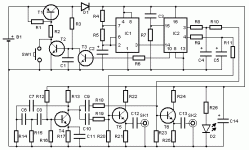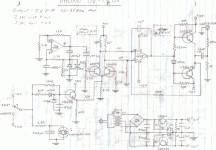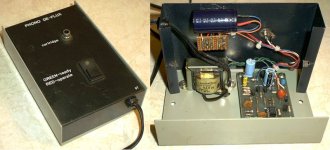Hi,
That surprises me. I can't think of any reason why it would have to be this high in frequency...
BTW, I think I once sent a circuit diagram for a demagnetiser to Mr. Feedback...Eric?
Not sure if it can be used on MC cartridges.
Cheers,
I thought of that, but one post earlier in the thread said they'd measured a 30KHz tone from a Fluxbuster output.
That surprises me. I can't think of any reason why it would have to be this high in frequency...
BTW, I think I once sent a circuit diagram for a demagnetiser to Mr. Feedback...Eric?
Not sure if it can be used on MC cartridges.
Cheers,
Hi Frank,
Yes you did.........Demagnetiser .
A pcb layout is given also.
"This originally was an article in the LLDIY Newsletter Issue 14 Jan/Feb 1994.
A Cartridge Demagnetiser
What on earth is a cartridge demagnetiser? Surely a cartridge requires magnetism in order to work? These were the first questions that came to mind when encountering this thing 5 or so years ago. It does not demagnetise the cartridge but instead the build up of small magnetic effects in other parts of the cartridge such as the core etc. This is only my understanding of it though. The part I don't understand is that people use these devices on their interconnects, power amps, speakers etc. and claim similar results. I have not yet.
The unit puts out a very small, distorted, high frequency wave form - that is all. The clever bit is the signal rises slowly and dies away slowly so as not to leave magnetic residuals. In comparison to the commercial unit the idea was taken from, this unit, once turned on will do one channel, then the other channel and then switch itself off. No chance of leaving it on and wasting the battery, no hassle of changing leads over. A friend of mine designed it and although it could be simpler, the extra complexity costs so little while adding to its ease of operation.
The results to my ears (and reports by others who have one) are amazing. It is as though someone has opened the window in a room full of stale air; like the system has just had a spring clean. "
Eric.
Yes you did.........Demagnetiser .
A pcb layout is given also.
"This originally was an article in the LLDIY Newsletter Issue 14 Jan/Feb 1994.
A Cartridge Demagnetiser
What on earth is a cartridge demagnetiser? Surely a cartridge requires magnetism in order to work? These were the first questions that came to mind when encountering this thing 5 or so years ago. It does not demagnetise the cartridge but instead the build up of small magnetic effects in other parts of the cartridge such as the core etc. This is only my understanding of it though. The part I don't understand is that people use these devices on their interconnects, power amps, speakers etc. and claim similar results. I have not yet.
The unit puts out a very small, distorted, high frequency wave form - that is all. The clever bit is the signal rises slowly and dies away slowly so as not to leave magnetic residuals. In comparison to the commercial unit the idea was taken from, this unit, once turned on will do one channel, then the other channel and then switch itself off. No chance of leaving it on and wasting the battery, no hassle of changing leads over. A friend of mine designed it and although it could be simpler, the extra complexity costs so little while adding to its ease of operation.
The results to my ears (and reports by others who have one) are amazing. It is as though someone has opened the window in a room full of stale air; like the system has just had a spring clean. "
Eric.
Attachments
Demagnetiser On A CD...............
Densen Demagic ...follow the products listing........reviews also.
Eric.
Densen Demagic ...follow the products listing........reviews also.
Eric.
I Have Not Tried Any Of This............
Hi Frank, thanks for reminding me that I had this from you........I had forgotten
The Denson disc claims subjective improvements for CD based systems including downstream cables etc.
To me this begs the experiment of plugging the phono cartridge rca leads into the line output of a CDP via a suitable attenuator ??????.
A preamp box that can divert CDP output back up the phono input ?????.
Feed the input stage and phono cart in parallel so as to condition them as a connected pair ??????.
That pcb could be easily dropped into a preamp box to provide this facility via relays etc........
Eric.
Hi Frank, thanks for reminding me that I had this from you........I had forgotten

The Denson disc claims subjective improvements for CD based systems including downstream cables etc.
To me this begs the experiment of plugging the phono cartridge rca leads into the line output of a CDP via a suitable attenuator ??????.
A preamp box that can divert CDP output back up the phono input ?????.
Feed the input stage and phono cart in parallel so as to condition them as a connected pair ??????.
That pcb could be easily dropped into a preamp box to provide this facility via relays etc........
Eric.
Hi,
When I noticed his absence a couple of months ago, I sent out an e-mail but it bounced.
At the same time I checked his shop's website and notice it was gone as well.
No idea what has become of Eric....
Anyone from Australia who knows more about this?
Cheers,
Just curious, anybody who knows where Mr Feedback, one of our top posters is these days? His home page is also gone.
When I noticed his absence a couple of months ago, I sent out an e-mail but it bounced.
At the same time I checked his shop's website and notice it was gone as well.
No idea what has become of Eric....
Anyone from Australia who knows more about this?
Cheers,
I thought of that, but one post earlier in the thread said they'd measured a 30KHz tone from a Fluxbuster output.
That surprises me. I can't think of any reason why it would have to be this high in frequency...
Frank, I'm very sure it was 33kHz and it was an original fluxbuster.
Also the amplitude was unexpexted high for MC, so the only thing I can think about it has something to do with the inductance of the coils. Due to this the high frequency will certain reduce the current through the coils, but this could also be done with a lower amplitude of the signal. So I guess the frequency is chosen for the best overall results.
Dick.
Back in the eighties when the Fluxbuster was first released I reverse-engineered it. It puts out a 5 volt peak-to-peak sine wave at about 33kHz, with a source impedance of about 50 ohms. It takes about two seconds for the waveform to achieve full output, it stays there for about 6 seconds, and then gradually decays to zero in about three seconds.
When I built my own version, I left out the logic circuitry that sets the 6 second "on" time and just wired in a pushbutton instead, so I can hold it on for as long as I like. A led with a 4700uF capacitor for the decay delay indicates when the process is complete and the cartridge can be safely unhooked.
I have attached a scan of my original completed schematic.
Take care,
Doug
When I built my own version, I left out the logic circuitry that sets the 6 second "on" time and just wired in a pushbutton instead, so I can hold it on for as long as I like. A led with a 4700uF capacitor for the decay delay indicates when the process is complete and the cartridge can be safely unhooked.
I have attached a scan of my original completed schematic.
Take care,
Doug
Attachments
Here is a picture of the fluxbuster clone that I built, both outside and inside. The pcb was done with Radio Shack rub-down etch-resist transfers, and apparently I built it in 1990, as that is the date on the pcb. This device has been used many times on a number of different cartridges, always with good results, but I've never tried it on cables or anything else. I always remove the stylus if I can (moving magnet cartridges) before using it, and it only does one channel at a time.
It actually makes a fairly easy and fun DIY project!
Take care,
Doug
It actually makes a fairly easy and fun DIY project!
Take care,
Doug
Attachments
- Status
- This old topic is closed. If you want to reopen this topic, contact a moderator using the "Report Post" button.
- Home
- Source & Line
- Analogue Source
- MC Cartridge De-magnetizing software for PC soundcard?


